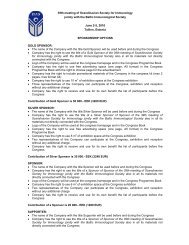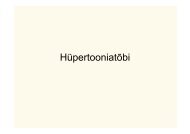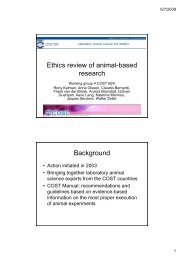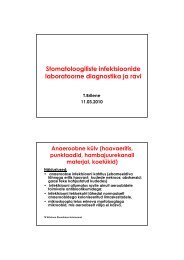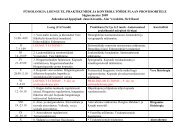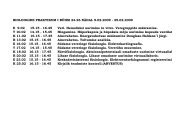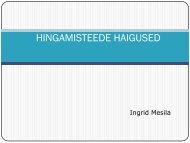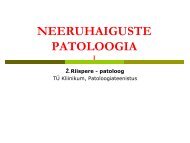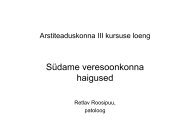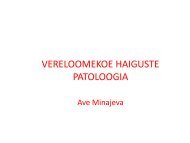Clobetasol 17-Propionate Cream as an Effective Preventive ...
Clobetasol 17-Propionate Cream as an Effective Preventive ...
Clobetasol 17-Propionate Cream as an Effective Preventive ...
Create successful ePaper yourself
Turn your PDF publications into a flip-book with our unique Google optimized e-Paper software.
Introduction<br />
Drug-induced peripheral vein phlebitis or thrombophlebitis<br />
is a very common clinical complication<br />
that occurs in 25 to 70% of all patients receiving<br />
intravenous therapy (Woodhouse, 1980; Tagalakis<br />
et al., 2002; Macklin, 2003). Drug-induced phlebitis<br />
is a v<strong>as</strong>cular <strong>an</strong>d periv<strong>as</strong>cular inflammatory<br />
reaction, characterised by polymorphonuclear cell<br />
infiltrate <strong>an</strong>d thrombi. In severe c<strong>as</strong>es the vessel<br />
wall becomes disorg<strong>an</strong>ised with intramural haemorrhages<br />
<strong>an</strong>d necrosis. This inflammatory process<br />
Sc<strong>an</strong>d. J. Lab. Anim. Sci. 2009 Vol. 36 No. 2<br />
<strong>Clobet<strong>as</strong>ol</strong> <strong>17</strong>-<strong>Propionate</strong> <strong>Cream</strong> <strong>as</strong> <strong>an</strong> <strong>Effective</strong> <strong>Preventive</strong><br />
Treatment for Drug Induced Superficial Thrombophlebitis<br />
by E Dvir * , S Russo, A Meshorer, R Duvdev<strong>an</strong>i & G Rosenberg<br />
D-Pharm Ltd., Rehovot, Israel<br />
Summary<br />
Commonly used therapies for thrombophlebitis have a high failure rate. There are sc<strong>an</strong>t data on the application<br />
of topical corticosteroids to treat thrombophlebitis. The present study investigated if the potent topical<br />
corticosteroid clobet<strong>as</strong>ol <strong>17</strong>-propionate cream (Dermovate, Glaxo Wellcome) c<strong>an</strong> be <strong>an</strong> effective treatment<br />
for drug-induced thrombophlebitis.<br />
DP-b99, a neuroprotective agent currently undergoing development for acute stroke, c<strong>an</strong> cause injectionsite<br />
phlebitis. DP-b99 w<strong>as</strong> administered at doses of 1 <strong>an</strong>d 2 mg/kg by a 1 hour intravenous infusion into the<br />
lateral ear vein of groups of 6 <strong>an</strong>d 5 rabbits, respectively. Each rabbit served <strong>as</strong> its own control by injecting<br />
both ears with DP-b99, while treating only one ear with clobet<strong>as</strong>ol cream immediately after treatment, with<br />
subsequent applications twice daily for 3 days. Phlebitis w<strong>as</strong> evaluated 1, 3, 5, 24, 32, 48, 56 <strong>an</strong>d 72 hours<br />
after DP-b99 treatment using a clinical score r<strong>an</strong>ging from 0 (no reaction) to 4. After 3 days the rabbits were<br />
sacrificed for histological <strong>an</strong>alysis of the ears.<br />
The phlebitis score w<strong>as</strong> highest at 24 hours. <strong>Clobet<strong>as</strong>ol</strong> treatment reduced the clinical scores at all time<br />
points <strong>an</strong>d shortened the course of phlebitis. Maximal effect w<strong>as</strong> observed 24-48 hours after the first application<br />
of clobet<strong>as</strong>ol cream. Histologically, there were fewer c<strong>as</strong>es of thrombophlebitis in the clobet<strong>as</strong>oltreated<br />
ears, <strong>an</strong>d those seen were milder <strong>an</strong>d more focal. To the best of the authors’ knowledge this appears<br />
to be the only study to report a phlebitis-ameliorating effect of a topical corticosteroid.<br />
*Correspondence: Dr. Er<strong>an</strong> Dvir<br />
Department of Comp<strong>an</strong>ion Animal Clinical Studies,<br />
Onderstepoort Veterinary Academic Hospital, University<br />
of Pretoria, Onderstepoort, 0110, Republic of South<br />
Africa.<br />
Tel. +27 12 529 8260<br />
Fax +27 12 529 8308<br />
E-mail er<strong>an</strong>.dvir@up.ac.za / edvir2000@yahoo.com<br />
may l<strong>as</strong>t up to 4 weeks (Woodhouse, 1980). Clinically,<br />
thrombophlebitis is characterised by pain,<br />
swelling, <strong>an</strong>d erythema. In the more severe c<strong>as</strong>es<br />
vein occlusion c<strong>an</strong> develop, <strong>an</strong>d secondary infection<br />
<strong>an</strong>d septicaemia may ensue (Woodhouse, 1980;<br />
Kh<strong>an</strong> et al., 1997; Tagalakis et al., 2002; Macklin,<br />
2003). Peripheral thrombophlebitis is often refractory<br />
to treatment <strong>an</strong>d frequently necessitates catheter<br />
removal <strong>an</strong>d insertion of a new catheter in <strong>an</strong><br />
alternative vein. Phlebitis is also a common, undocumented<br />
clinical problem in laboratory <strong>an</strong>imals,<br />
especially rabbits.<br />
The metal ion chelator DP-b99 is a newly developed<br />
lipophilic derivative of BAPTA (1,2-bis(2aminophenoxy)eth<strong>an</strong>e-N,N,N’,N’-tetraacetic<br />
acid),<br />
which modulates the distribution of metal ions in<br />
hydrophobic media. DP-b99 is currently undergoing<br />
clinical development <strong>as</strong> <strong>an</strong> intravenouslyadministered<br />
neuroprotect<strong>an</strong>t for acute ischemic<br />
Published in the Sc<strong>an</strong>dinavi<strong>an</strong> Journal of Laboratory Animal Science - <strong>an</strong> international journal of laboratory <strong>an</strong>imal science<br />
1231
Sc<strong>an</strong>d. J. Lab. Anim. Sci. 2009 Vol. 36 No. 2<br />
stroke (Rosenberg et al., 2004). Phlebitis at the site<br />
of intravenous administration w<strong>as</strong> DP-b99’s most<br />
frequently reported adverse event in this drug’s initial<br />
evaluation in healthy volunteers (Rosenberg et<br />
al., 2005), <strong>an</strong>d the goal of the current study w<strong>as</strong> to<br />
find <strong>an</strong> appropriate preventive treatment for DP-b99<br />
induced phlebitis without interfering with its therapeutic<br />
effect in stroke patients.<br />
Few systemic treatments have been tested for peripheral<br />
vein phlebitis, <strong>an</strong>d even fewer were attempted<br />
<strong>as</strong> a prophylactic approach (Dobbins et<br />
al., 2003). These systemic studies usually employed<br />
heparin combined with cortisone (Tighe et<br />
al., 1995; Dobbins et al., 2003) or heparin alone<br />
(R<strong>an</strong>dolph et al., 1998; Marchiori et al., 2002).<br />
Heparin aided fluid flow through the catheter <strong>an</strong>d<br />
reduced the risk of phlebitis; however this effect<br />
w<strong>as</strong> not always satisfactory <strong>an</strong>d the haemorrhagic<br />
side effects of systemic <strong>an</strong>ti-coagulation may be<br />
very serious (R<strong>an</strong>dolph et al., 1998; Marchiori et<br />
al., 2002). Systemic treatment with the non steroidal<br />
<strong>an</strong>ti-inflammatory drug (NSAID) diclofenac<br />
showed some benefit in reducing the clinical signs<br />
of phlebitis (Becherucci et al., 2000), but it also h<strong>as</strong><br />
potentially serious side effects.<br />
As with systemic treatments, few topical drugs<br />
have been proposed for the treatment or prevention<br />
of peripheral vein thrombophlebitis. <strong>Preventive</strong><br />
topical treatment with a glyceryl trinitrate patch<br />
showed benefit in prolonging the survival time of<br />
the c<strong>an</strong>nula <strong>an</strong>d in reducing the prevalence of phlebitis<br />
(Wright et al., 1985; Khawaja et al., 1991).<br />
Topical glyceryl trinitrate w<strong>as</strong> tested in combination<br />
with systemic heparin <strong>an</strong>d hydrocortisone<br />
(Tighe et al., 1995), but in a subsequent study its<br />
additional benefit w<strong>as</strong> doubtful (Dobbins et al.,<br />
2003). The effect of glyceryl trinitrate is believed<br />
to be through v<strong>as</strong>odilatation, but even with a topical<br />
preparation this compound c<strong>an</strong> lead to adverse<br />
systemic effects such <strong>as</strong> hypotension <strong>an</strong>d headache<br />
(Dobbins et al., 2003). Topical heparin alone w<strong>as</strong><br />
also found to relieve the symptoms of phlebitis<br />
(Mehta et al., 1975; Gorski et al., 2005). Several<br />
topical NSAIDs including naproxen (Cokmez et<br />
2124<br />
al., 2003), felbinac gel (Payne-James et al., 1992),<br />
<strong>an</strong>d diclofenac (Becherucci et al., 2000) were tried<br />
with some success in reducing the clinical signs of<br />
phlebitis <strong>an</strong>d overall reduction in the incidence of<br />
thrombophlebitis. Surprisingly, topical treatment<br />
with steroids w<strong>as</strong> hardly ever evaluated in peripheral<br />
vein phlebitis, with one exception of <strong>an</strong> early<br />
work with a preparation of adrenocortical extract<br />
<strong>an</strong>d salicylic acid which reduced the incidence<br />
of thrombophlebitis by nearly 50% (Woodhouse,<br />
1979).<br />
<strong>Clobet<strong>as</strong>ol</strong> cream, <strong>an</strong> ultra-high-potency corticosteroid,<br />
h<strong>as</strong> been effective in treating difficult<br />
inflammatory skin conditions such <strong>as</strong> psori<strong>as</strong>is<br />
(Stein, 2005), atopic dermatitis (Brenem<strong>an</strong> et al.,<br />
2005) <strong>an</strong>d bullous pemphigoid (Fontaine et al.,<br />
2003). In the current study we <strong>as</strong>sessed the cream<br />
preparation of clobet<strong>as</strong>ol <strong>as</strong> a topical treatment for<br />
DP-b99-induced phlebitis in a rabbit model. The<br />
marginal ear vein of the rabbit is <strong>an</strong> established<br />
model for <strong>as</strong>sessment of drug-induced thrombophlebitis<br />
(Johnson et al., 1989), <strong>an</strong>d previous<br />
studies have characterised this model clinically <strong>an</strong>d<br />
histopathologically (Kuwahara et al., 1998). The<br />
phlebitogenic properties of several drugs such <strong>as</strong><br />
diazepam (Levy et al., 1989; White & Yalkowsky,<br />
1991), amioderone (Ward et al., 1991) <strong>an</strong>d bisatrene<br />
(Powis & Kovach, 1983) were studied in this<br />
model. The current study utilized this model to <strong>as</strong>ses<br />
the response to <strong>an</strong>ti-phlebitis treatment following<br />
the use of DP-b99. The hypothesis of this study<br />
w<strong>as</strong> that clobet<strong>as</strong>ol will have a preventive effect on<br />
the development of DP-b99-induced phlebitis in<br />
the marginal ear vein of the rabbit.<br />
Materials <strong>an</strong>d Methods<br />
The D-Pharm Institutional Animal Care <strong>an</strong>d Use<br />
Committee, which works under the Israeli National<br />
Council for Experiments in Laboratory Animals,<br />
according to Israeli law <strong>an</strong>d the U.S. National Institutes<br />
of Health guidelines for the care <strong>an</strong>d use of<br />
laboratory <strong>an</strong>imals, approved all the studies.<br />
Eleven, pathogen-free, male, outbred New Zeal<strong>an</strong>d<br />
White rabbits Oryctolagus cuniculus (Harl<strong>an</strong>, Jeru-
salem, Israel), 14-15 weeks old <strong>an</strong>d weighing 2.4-3<br />
kg, were used in the study. The rabbits were quar<strong>an</strong>tined<br />
5 days for acclimatization before the study.<br />
All rabbits were clinically healthy prior to the study.<br />
They were housed in individual wire cages 65 x 65<br />
x45 cm with a perforated pl<strong>as</strong>tic floor <strong>an</strong>d collection<br />
pen (Tecnipl<strong>as</strong>t, Varese, Italy). The rabbits were<br />
housed in controlled environmental conditions:<br />
temperature 20º-22ºC, relative humidity 30-55%<br />
<strong>an</strong>d a 12 hours light/dark cycle. The rabbits were<br />
fed st<strong>an</strong>dard rabbit diet (7078s Sterilizable Doe<br />
Rabbit Diet, Teklad, Madison, WI, USA) <strong>an</strong>d fresh<br />
water ad libitum.<br />
The rabbits were divided into 2 dose groups that<br />
received 1 mg/kg (n=6) or 2 mg/kg (n=5) DP-b99<br />
to each ear. The drug subst<strong>an</strong>ce w<strong>as</strong> dissolved in<br />
normal saline (B.Braun, Germ<strong>an</strong>y) <strong>an</strong>d w<strong>as</strong> administered<br />
at a concentration of 0.4 mg/ml or 0.8 mg/<br />
ml. The marginal (lateral) ear veins of each rabbit<br />
were c<strong>an</strong>nulated with a 24g venflon c<strong>an</strong>nula<br />
(Romed, Wilnis, Holl<strong>an</strong>d) <strong>an</strong>d 2.5 ml/kg of the test<br />
subst<strong>an</strong>ce w<strong>as</strong> administered <strong>as</strong> a continuous infusion<br />
over 1 hour, using <strong>an</strong> infusion pump (Harvard<br />
Apparatus, South Natick, M<strong>as</strong>s, USA). C<strong>an</strong>nulation<br />
<strong>an</strong>d infusion were under general light <strong>an</strong>aesthesia:<br />
the rabbits were premedicated with acepromazine<br />
(C-Vet, L<strong>an</strong>c<strong>as</strong>hire, UK) 1 mg/kg intramuscularly<br />
(IM) <strong>an</strong>d <strong>an</strong>aesthetised with xylazine (VMD, Arendonk,<br />
Belgium) 3 mg/kg <strong>an</strong>d ketamine (Fort Dodge,<br />
Iowa, USA) 50 mg/kg IM. Each rabbit served <strong>as</strong> its<br />
own control by infusing one ear with DP-b99 <strong>an</strong>d<br />
the other ear with DP-b99 followed immediately<br />
by the application of clobet<strong>as</strong>ol cream (0.05% w/w,<br />
Demovate, GlaxoWellcome, Uxbridge, UK). Additionally,<br />
clobet<strong>as</strong>ol cream w<strong>as</strong> applied twice a day<br />
throughout the 3 study days. The cream w<strong>as</strong> applied<br />
gently to the infusion site, <strong>an</strong>d the rabbits were restrained<br />
or guarded to prevent licking for <strong>an</strong> hour<br />
after the application.<br />
Phlebitis w<strong>as</strong> evaluated twice daily by me<strong>an</strong>s of<br />
clinical score according to the following scale (Levy<br />
et al., 1989):<br />
0 = no reaction.<br />
1 = ch<strong>an</strong>ges in vein colour <strong>an</strong>d thickness without<br />
Sc<strong>an</strong>d. J. Lab. Anim. Sci. 2009 Vol. 36 No. 2<br />
ch<strong>an</strong>ges surrounding the vein.<br />
2 = ch<strong>an</strong>ges in vein colour <strong>an</strong>d thickness accomp<strong>an</strong>ied<br />
by erythema or oedema limited to the proximity<br />
of the vein.<br />
3 = ch<strong>an</strong>ges in vein colour <strong>an</strong>d thickness accomp<strong>an</strong>ied<br />
by wide erythema or oedema around the vein<br />
up to the level of the central artery.<br />
4 = ch<strong>an</strong>ges in vein colour <strong>an</strong>d thickness accomp<strong>an</strong>ied<br />
by erythema or oedema surrounding the vein,<br />
reaching <strong>an</strong>d exceeding the central artery.<br />
The clinical score w<strong>as</strong> evaluated 1, 3, 5, 24, 32, 48,<br />
56 <strong>an</strong>d 72 hours after drug administration. Seventytwo<br />
hours after the infusion the rabbits were <strong>an</strong>aesthetised<br />
with xylazine (VMD, Arendonk, Belgium)<br />
3 mg/kg <strong>an</strong>d ketamine (Fort Dodge, Iowa, USA)<br />
50 mg/kg IM <strong>an</strong>d then euth<strong>an</strong>aised with pentobarbitone<br />
(CTS, Kiryat Malachi, Israel) 200 mg/kg<br />
intra cardiac. Samples of 3 centimetres of the ear<br />
vein from the point of the tip of the c<strong>an</strong>nula <strong>an</strong>d<br />
distally were excised <strong>an</strong>d subjected to pathological<br />
microscopic <strong>an</strong>alysis. Samples for histology were<br />
prepared by a st<strong>an</strong>dard procedure <strong>an</strong>d were stained<br />
with Hematoxylin Eosin. Histology w<strong>as</strong> performed<br />
under light microscopy. The pathologist (AM) w<strong>as</strong><br />
blinded to the treatment procedure. The lateral ear<br />
vein w<strong>as</strong> specifically evaluated for the presence of<br />
thrombus <strong>an</strong>d phlebitis. The histology findings were<br />
graded according to the following criteria, that were<br />
adapted from Kuwahara (1998):<br />
Thrombus<br />
None<br />
Small – 2/3 of the vein in cross-section<br />
Phlebitis:<br />
None<br />
Mild – Few inflammatory cells in venous wall or<br />
periv<strong>as</strong>cular tissue<br />
Moderate – M<strong>an</strong>y inflammatory cells in venous<br />
wall or periv<strong>as</strong>cular tissue<br />
Severe – Diffuse <strong>an</strong>d denser inflammatory cells in<br />
venous wall or periv<strong>as</strong>cular tissue<br />
1253
Sc<strong>an</strong>d. J. Lab. Anim. Sci. 2009 Vol. 36 No. 2<br />
Statistical <strong>an</strong>alysis<br />
The clobet<strong>as</strong>ol treatment effect w<strong>as</strong> calculated by<br />
firstly subtracting the clobet<strong>as</strong>ol-treated ear score<br />
from the non-treated ear score. The multiple me<strong>as</strong>ures<br />
over time were converted to a single continuous<br />
parameter by calculating the area under each<br />
rabbit curve. We then did a st<strong>an</strong>dard ANOVA with<br />
dose <strong>as</strong> a factor. Since dose w<strong>as</strong> not signific<strong>an</strong>t<br />
(F 1,9 = 2.365, P = 0.1584) it w<strong>as</strong> deleted from the<br />
model. We then only tested (by ANOVA) whether<br />
the me<strong>an</strong> response to clobet<strong>as</strong>ol treatment w<strong>as</strong> signific<strong>an</strong>tly<br />
different from 0 for the overall area under<br />
the curve (overall time). For specific time points we<br />
used the Sign R<strong>an</strong>k Test. The effect of clobet<strong>as</strong>ol<br />
over time w<strong>as</strong> also <strong>as</strong>sessed via a quadratic model<br />
allowing r<strong>an</strong>dom effects for the linear <strong>an</strong>d quadratic<br />
coefficients. The differences in prevalence of histological<br />
lesions between groups were evaluated by<br />
chi-square test. A p-value of 0.05 w<strong>as</strong> considered<br />
signific<strong>an</strong>t.<br />
Results<br />
DP-b99 1 mg/kg induced mild phlebitis with me<strong>an</strong><br />
peak score (± st<strong>an</strong>dard error) of 1.58 ± 0.27 after<br />
24 hours (Fig. 1). When treated with clobet<strong>as</strong>ol the<br />
phlebitis almost disappeared, with a 24 hours peak<br />
score of 1.00 ± 0.26 (Fig. 1), which represents a<br />
very mild phlebitis that would hardly be detected<br />
in a clinical setting. With DP-b99 dose of 2 mg/kg,<br />
the me<strong>an</strong> 24 hours score observed without clobeta-<br />
Phlebitis Score<br />
2<br />
1.8<br />
1.6<br />
1.4<br />
1.2<br />
1<br />
0.8<br />
0.6<br />
0.4<br />
0.2<br />
Figure 1. Phlebitis score monitored over 72 hours<br />
post administration of DP-b99 1 mg/kg/ear with or<br />
without topical clobet<strong>as</strong>ol. Data presented <strong>as</strong> me<strong>an</strong><br />
± st<strong>an</strong>dard error (n=6).<br />
4126<br />
0<br />
0 10 20 30 40 50 60 70 80<br />
Time (h)<br />
DP-b99 + clobet<strong>as</strong>ol<br />
DP-b99 only<br />
Phlebitis Score<br />
2.5<br />
2<br />
1.5<br />
1<br />
0.5<br />
0<br />
0 10 20 30 40 50 60 70 80<br />
Time (h)<br />
DP-b99 + clobet<strong>as</strong>ol<br />
DP-b99 only<br />
Figure 2. Phlebitis score monitored over 72 hours<br />
post administration of DP-b99 2 mg/kg/ear with or<br />
without topical clobet<strong>as</strong>ol. Data presented <strong>as</strong> me<strong>an</strong><br />
± st<strong>an</strong>dard error (n=5).<br />
sol treatment w<strong>as</strong> 1.90 ± 0.40 <strong>an</strong>d with clobet<strong>as</strong>ol<br />
1.00 ± 0.00 (Fig. 2). The time courses of the<br />
phlebitis in the untreated ears for the 2 doses were<br />
similar. There w<strong>as</strong> <strong>an</strong> early small peak in the score<br />
3 hours after drug administration - probably due<br />
to both mech<strong>an</strong>ical irritation from the c<strong>an</strong>nulation<br />
<strong>an</strong>d a reaction to DP-b99. However, this initial irritation<br />
subsided after 5 hours <strong>an</strong>d then the signs<br />
of inflammation incre<strong>as</strong>ed again, probably <strong>as</strong> a reaction<br />
to the drug subst<strong>an</strong>ce. The highest clinical<br />
score w<strong>as</strong> obtained 24 hours post-administration<br />
for both doses. After 24 hours the clinical score<br />
decre<strong>as</strong>ed slowly in both clobet<strong>as</strong>ol treated <strong>an</strong>d<br />
non-treated ears. The difference in score-time area<br />
under the curve between the rabbit’s clobet<strong>as</strong>ol<br />
treated non–treated ears revealed signific<strong>an</strong>t differences<br />
(F 1,11 = 23.128, P < 0.001), indicating the<br />
overall effect of the clobet<strong>as</strong>ol. The <strong>an</strong>alysis of the<br />
effect revealed signific<strong>an</strong>t effects at 3 (p=0.016),<br />
24 (p=0.031), 32 (p=0.008) <strong>an</strong>d 48 (p=0.016)<br />
hours. To estimate the slope of the clobet<strong>as</strong>ol effect<br />
at various times, a quadratic model which allows<br />
for r<strong>an</strong>dom effects w<strong>as</strong> used. It yielded slope<br />
estimates of 0.022 at 5 hours (p=0.002), 0.018 at<br />
10 hours (p=0.003), 0.015 at 15 hours (p=0.005),<br />
-0.010 at 48 hours (p=0.023) <strong>an</strong>d –0.016 at 56<br />
hours (p=0.005). These results indicate that there<br />
is a slower development of phlebitis (signific<strong>an</strong>tly<br />
positive slope prior to 32 hours) with clobet<strong>as</strong>ol,<br />
<strong>an</strong>d <strong>an</strong> expedited healing process after 32 hours
(a negative slope). Similar results were obtained<br />
while <strong>an</strong>alysing each dose (either 1 mg/kg or 2 mg/<br />
kg) separately (Fig. 3).<br />
On histological <strong>as</strong>sessment of the 1 mg/kg DP-b99<br />
treated rabbits, only 1 ear treated with clobet<strong>as</strong>ol <strong>an</strong>d<br />
1 ear without clobet<strong>as</strong>ol showed mild periv<strong>as</strong>cular<br />
inflammatory cellular infiltrate. However, thrombus<br />
w<strong>as</strong> evident in 2/6 clobet<strong>as</strong>ol <strong>an</strong>d 4/6 non-clobet<strong>as</strong>ol<br />
treated ears (Table 1). This w<strong>as</strong> in agreement<br />
with the minimal clinical scores observed in this<br />
group 72 hours post drug administration. The histological<br />
<strong>an</strong>alysis of the ears after the 2 mg/kg dose<br />
revealed phlebitis in 3/5 (1 mild, 2 moderate) of<br />
the control ears <strong>an</strong>d mild phlebitis in 1/5 of rabbits<br />
that w<strong>as</strong> treated with clobet<strong>as</strong>ol. This is in agreement<br />
with the clinical results that show a positive<br />
effect for clobet<strong>as</strong>ol in reducing DP-b99-induced<br />
phlebitis. The inflammatory infiltrate w<strong>as</strong> a mixture<br />
of gr<strong>an</strong>ulocytes <strong>an</strong>d macrophages consistent with a<br />
sub-acute reaction (Table 1). Chi square <strong>an</strong>alysis of<br />
the histological findings w<strong>as</strong> not signific<strong>an</strong>t.<br />
Sc<strong>an</strong>d. J. Lab. Anim. Sci. 2009 Vol. 36 No. 2<br />
Figure 3. Difference in phlebitis score between<br />
ears treated with DP-b99 without clobet<strong>as</strong>ol cream<br />
<strong>an</strong>d with clobet<strong>as</strong>ol over time. Three plots are presented;<br />
treatment with DP- b99 1 mg/kg/ear (n=6),<br />
DP-b99 2 mg/kg/ear (n=5) <strong>an</strong>d a combined plot of<br />
the 2 treatments (n=11). Data presented <strong>as</strong> me<strong>an</strong><br />
± st<strong>an</strong>dard error. Note the positive slope until 24<br />
hours indicating reduced phlebitis reaction <strong>an</strong>d the<br />
negative slope after 32 hours indicating expedited<br />
healing process.<br />
Table 1. Prevalence of histopathological lesions 72 hours post administration of DP-b99 1 mg/kg or 2 mg/<br />
kg with or without clobet<strong>as</strong>ol.<br />
Difference in phlebitis score<br />
1.4<br />
1.2<br />
1<br />
0.8<br />
0.6<br />
0.4<br />
0.2<br />
0<br />
-0.2<br />
-0.4<br />
1 3 5 24 32 48 56 72<br />
Time (h)<br />
1mg/kg<br />
2mg/kg<br />
Combined<br />
Treatment Number of Prevalence of Prevalence Prevalence of<br />
rabbits phlebitis of thrombus no pathology<br />
DP-b99 1 mg/kg 6 1/6 2/6 4/6<br />
With clobet<strong>as</strong>ol (1 mild) (2 medium)<br />
DP-b99 1 mg/kg 6 1/6 4/6 2/6<br />
Without clobet<strong>as</strong>ol (1 mild) (1 small, 3 medium)<br />
DP-b99 2 mg/kg 5 1/5 2/5 3/5<br />
With clobet<strong>as</strong>ol (1 mild) (1 small, 1 large)<br />
DP-b99 2 mg/kg 5 3/5 3/5 2/5<br />
Without clobet<strong>as</strong>ol (1 mild, 2 moderate) (3 large)<br />
Phlebitis w<strong>as</strong> graded <strong>as</strong>: mild – few inflammatory cells in the venous wall or periv<strong>as</strong>cular tissue; moderate<br />
– m<strong>an</strong>y inflammatory cells in the venous wall or periv<strong>as</strong>cular tissue; or severe – diffuse <strong>an</strong>d denser<br />
inflammatory cells in the venous wall or periv<strong>as</strong>cular tissue. Thrombus w<strong>as</strong> graded <strong>as</strong>: small – 2/3 of the vein in<br />
cross-section.<br />
1275
Sc<strong>an</strong>d. J. Lab. Anim. Sci. 2009 Vol. 36 No. 2<br />
Discussion<br />
The pathogenesis of DP-b99-induced phlebitis is<br />
unclear. In hum<strong>an</strong>s the phlebitis w<strong>as</strong> mostly mild<br />
<strong>an</strong>d w<strong>as</strong> observed more frequently in young subjects<br />
th<strong>an</strong> in the elderly (Rosenberg et al., 2005). In<br />
the present study, the mild inflammatory histological<br />
signs do not hint clearly at the mech<strong>an</strong>ism underlying<br />
the DP-b99 pro-phlebitic effect; however,<br />
the relatively high prevalence of thrombi may indicate<br />
endothelial injury. The mixed inflammatory<br />
infiltrate indicates a response to <strong>an</strong> acute irritation<br />
<strong>an</strong>d possibly endothelial injury. No precipitation of<br />
the drug subst<strong>an</strong>ce w<strong>as</strong> observed microscopically.<br />
The rabbit’s marginal ear vein is a very sensitive<br />
model for peripheral phlebitis (Kuwahara et al.,<br />
1998) <strong>as</strong> the veins are very superficial <strong>an</strong>d thin,<br />
the interstitium h<strong>as</strong> limited space, <strong>an</strong>d the lack of<br />
pigment in albino <strong>an</strong>imals makes the inflammation<br />
e<strong>as</strong>ily discernible. This model w<strong>as</strong> frequently<br />
used to demonstrate local toxicity after intravenous<br />
administration, but h<strong>as</strong> not been used routinely to<br />
<strong>as</strong>sess thrombophlebitis therapy. For the same re<strong>as</strong>ons,<br />
mentioned above, it should be just <strong>as</strong> sensitive<br />
in demonstrating resolution of phlebitis. Indeed, to<br />
our knowledge the current study is the first to employ<br />
this model to such <strong>an</strong> end.<br />
<strong>Clobet<strong>as</strong>ol</strong> reduced both the peak score of the phlebitis<br />
<strong>an</strong>d shortened the healing process. To the best<br />
of our knowledge apart from <strong>an</strong> early study using<br />
adrenocortical extract (Woodhouse, 1979), this<br />
appears to be the only study to report a phlebitisameliorating<br />
effect of a topical corticosteroid. In<br />
our study the phlebitis w<strong>as</strong> self limiting even without<br />
treatment, <strong>as</strong> may be expected after a single<br />
administration of <strong>an</strong> irritating agent; however, this<br />
may not be the c<strong>as</strong>e with repeated administrations,<br />
e.g. when administering parenteral nutrition, where<br />
the phlebitis c<strong>an</strong> progressively worsen. <strong>Clobet<strong>as</strong>ol</strong><br />
h<strong>as</strong> the potential to prevent this perpetuating c<strong>as</strong>cade<br />
with minimal side effects after being applied<br />
locally. Few local treatments have been attempted<br />
for phlebitis in hum<strong>an</strong> patients. Trinitrates have<br />
potentially serious side effects, especially in elderly<br />
people (Wright et al., 1985) <strong>an</strong>d their benefit<br />
6128<br />
is questionable (Dobbins et al., 2003). The topical<br />
NSAID felbinac showed only reduction in hardness<br />
around the c<strong>an</strong>nula, but not in erythema pain<br />
or oedema (Payne-James et al., 1992). In topical<br />
or systemic administration it showed improvement<br />
in all clinical parameters tested, namely hardness,<br />
eryrthema, heat <strong>an</strong>d pain, but adverse reactions<br />
were reported following either mode of administration<br />
(Cokmez et al., 2003). A topical heparin formulation<br />
w<strong>as</strong> reported to reduce erythema <strong>an</strong>d pain<br />
<strong>an</strong>d to induce thrombus regression (Gorski et al.,<br />
2005). Another study with topical heparinoid ointment<br />
showed a quicker relief of the clinical signs<br />
(Mehta et al., 1975). The evaluation in the current<br />
study combined a variety of clinical <strong>an</strong>d histological<br />
parameters <strong>an</strong>d demonstrated the efficacy of<br />
topical clobet<strong>as</strong>ol. The study h<strong>as</strong> a few limitations:<br />
the clinical scoring w<strong>as</strong> not blinded, the group size<br />
w<strong>as</strong> small <strong>an</strong>d the irrit<strong>an</strong>t w<strong>as</strong> mild; therefore, further<br />
investigations, with larger study groups <strong>an</strong>d<br />
other drugs with phlebitogenic potential should be<br />
performed. Clearly, one c<strong>an</strong>not directly tr<strong>an</strong>spose<br />
<strong>an</strong>imal-b<strong>as</strong>ed data to hum<strong>an</strong> patients but our study<br />
warr<strong>an</strong>ts <strong>an</strong> evaluation of topical steroids in hum<strong>an</strong><br />
chemical thrombophlebitis. Local application of<br />
potent corticosteroids, if found effective in hum<strong>an</strong>s,<br />
have the potential to replace or supplement the current<br />
treatment with heparin or NSAIDs.<br />
Acknowledgements<br />
The authors acknowledge Zarina Krakovsky for her<br />
contribution in processing the histological specimens<br />
<strong>an</strong>d Lea Bello for her technical <strong>as</strong>sist<strong>an</strong>ce in<br />
performing the experiments.<br />
References<br />
Becherucci A, D Bagilet, J Marenghini, M Diab<br />
& H Bi<strong>an</strong>cardi: [Effect of topical <strong>an</strong>d oral diclofenac<br />
on superficial thrombophlebitis caused<br />
by intravenous infusion]. Med Clin (Barc).<br />
2000, 114, 371-373.<br />
Brenem<strong>an</strong> D, AB, Fleischer Jr., D Kapl<strong>an</strong>, M Lebwohl,<br />
B Miller, D Pariser, T Rist, L Swinyer, Y<br />
Liu & V Foley: <strong>Clobet<strong>as</strong>ol</strong> propionate 0.05%
lotion in the treatment of moderate to severe atopic<br />
dermatitis: a r<strong>an</strong>domized evaluation versus<br />
clobet<strong>as</strong>ol propionate emollient cream. J Drugs<br />
Dermatol. 2005, 4, 330-336.<br />
Cokmez A, S Gur, H Genc, S Deniz & E Tarc<strong>an</strong>: Effect<br />
of tr<strong>an</strong>sdermal glyceryl trinitrate <strong>an</strong>d <strong>an</strong>tiinflammatory<br />
gel in infusion phlebitis. ANZ J<br />
Surg. 2003, 73, 794-796.<br />
Dobbins BM, JA Catton, MJ Tighe, GV Miller, IG<br />
Martin & MJ McMahon: R<strong>an</strong>domized clinical<br />
trials to determine the role of topical glyceryl<br />
trinitrate in peripheral intravenous nutrition. Br<br />
J Surg. 2003, 90, 804-810.<br />
Fontaine J, P Joly & JC Roujeau: Treatment of bullous<br />
pemphigoid. J Dermatol. 2003, 30, 83-90.<br />
Gorski G, P Szopinski, J Michalak, A Mari<strong>an</strong>owska,<br />
M Borkowski, M Geremek, M Trochimczuk, J<br />
Brot<strong>an</strong>ek, S Sarnik, J Semenka, D Wilkowski &<br />
W Noszczyk: Liposomal heparin spray: a new<br />
formula in adjunctive treatment of superficial<br />
venous thrombosis. Angiology. 2005, 56, 9-<strong>17</strong>.<br />
Johnson JV, AH Jeske, HK McD<strong>an</strong>iel & GQ Herrera:<br />
Development of <strong>an</strong> in vivo model for <strong>as</strong>sessment<br />
of drug-induced v<strong>as</strong>cular injury. J<br />
Oral Maxillofac Surg. 1989, 47, 819-822.<br />
Kh<strong>an</strong> EA, AG Correa & CJ Baker: Suppurative<br />
thrombophlebitis in children: a ten-year experience.<br />
Pediatr Infect Dis J. 1997, 16, 63-67.<br />
Khawaja HT, JD Williams & PC Weaver: Tr<strong>an</strong>sdermal<br />
glyceryl trinitrate to allow peripheral total<br />
parenteral nutrition: a double-blind placebo<br />
controlled fe<strong>as</strong>ibility study. J R Soc Med. 1991,<br />
84, 69-72.<br />
Kuwahara T, S As<strong>an</strong>ami & S Kubo: Experimental<br />
infusion phlebitis: toler<strong>an</strong>ce osmolality of peripheral<br />
venous endothelial cells. Nutrition.<br />
1998, 14, 496-501.<br />
Levy MY, L L<strong>an</strong>germ<strong>an</strong>, S Gottschalk-Sabag & S<br />
Benita: Side-effect evaluation of a new diazepam<br />
formulation: venous sequela reduction<br />
following intravenous (i.v.) injection of a diazepam<br />
emulsion in rabbits. Pharm Res. 1989,<br />
6, 510-516.<br />
Macklin D: Phlebitis. Am J Nurs. 2003, 103, 55-<br />
Sc<strong>an</strong>d. J. Lab. Anim. Sci. 2009 Vol. 36 No. 2<br />
60.<br />
Marchiori A, F Verlato, P Sabbion, G Camporese,<br />
F Rosso, L Mosena, GM Andreozzi & P Pr<strong>an</strong>doni:<br />
High versus low doses of unfractionated<br />
heparin for the treatment of superficial thrombophlebitis<br />
of the leg. A prospective, controlled,<br />
r<strong>an</strong>domized study. Haematologica. 2002,<br />
87, 523-527.<br />
Mehta PP, S Sagar & VV Kakkar: Treatment of superficial<br />
thrombophlebitis: a r<strong>an</strong>domized, double-blind<br />
trial of heparinoid cream. Br Med J.<br />
1975, 3, 614-616.<br />
Payne-James JJ, MJ Bray, S Kapadia, SK R<strong>an</strong>a, D<br />
McSwigg<strong>an</strong> & DB Silk: Topical nonsteroidal<br />
<strong>an</strong>ti-inflammatory gel for the prevention of peripheral<br />
vein thrombophlebitis. A double-blind,<br />
r<strong>an</strong>domised, placebo-controlled trial in normal<br />
subjects. Anaesthesia. 1992, 47, 324-326.<br />
Powis G & Kovach JS: Disposition of bis<strong>an</strong>trene in<br />
hum<strong>an</strong>s <strong>an</strong>d rabbits: evidence for intrav<strong>as</strong>cular<br />
deposition of drug <strong>as</strong> a cause of phlebitis. C<strong>an</strong>cer<br />
Res . 1983, 43, 925-929.<br />
R<strong>an</strong>dolph AG, DJ Cook, CA Gonzales & M Andrew:<br />
Benefit of heparin in peripheral venous <strong>an</strong>d<br />
arterial catheters: systematic review <strong>an</strong>d meta<strong>an</strong>alysis<br />
of r<strong>an</strong>domised controlled trials. Bmj.<br />
1998, 316, 969-975.<br />
Rosenberg G, I Angel & A Kozak: Clinical pharmacology<br />
of DP-b99 in healthy volunteers: first<br />
administration to hum<strong>an</strong>s. Br J Clin Pharmacol.<br />
2005, 60, 7-16.<br />
Rosenberg G, I Angel, A Kozak & D Schnelder:<br />
Evaluation of safety <strong>an</strong>d ch<strong>an</strong>ges in the NIH<br />
stroke scale, r<strong>an</strong>kin, <strong>an</strong>d Barthel scores following<br />
DP-b99 administration in acute stroke patients.<br />
Stroke. 2004, 35, 338.<br />
Stein L: Clinical studies of a new vehicle formulation<br />
for topical corticosteroids in the treatment<br />
of psori<strong>as</strong>is. J Am Acad Dermatol. 2005, 53,<br />
S39-49.<br />
Tagalakis V, SR Kahn, M Libm<strong>an</strong> & M Blostein:<br />
The epidemiology of peripheral vein infusion<br />
thrombophlebitis: a critical review. Am J Med.<br />
2002, 113, 146-151.<br />
1297
Sc<strong>an</strong>d. J. Lab. Anim. Sci. 2009 Vol. 36 No. 2<br />
Tighe MJ, C Wong, IG Martin & MJ McMahon: Do<br />
heparin, hydrocortisone, <strong>an</strong>d glyceryl trinitrate<br />
influence thrombophlebitis during full intravenous<br />
nutrition via a peripheral vein? JPEN J<br />
Parenter Enteral Nutr. 1995, 19, 507-509.<br />
Ward GH, PE, Nol<strong>an</strong> Jr., M White & SH Yalkowsky:<br />
Studies in phlebitis. II. Early detection of amiodarone-induced<br />
phlebitis in a rabbit model.<br />
Pharm Res. 1991, 8, 801-803.<br />
White M & SH Yalkowsky: Studies in phlebitis. III.<br />
Evaluation of diazepam <strong>an</strong>d phenytoin. Pharm<br />
8130<br />
Res. 1991, 8, 1341-1342.<br />
Woodhouse CR: Movelat in the prophylaxis of infusion<br />
thrombophlebitis. Br Med J. 1979, 1, 454-<br />
455.<br />
Woodhouse CR: Infusion thrombophlebitis: the histological<br />
<strong>an</strong>d clinical features. Ann R Coll Surg<br />
Engl. 1980, 62, 364-368.<br />
Wright A, JF Hecker & GB Lewis: Use of tr<strong>an</strong>sdermal<br />
glyceryl trinitrate to reduce failure of intravenous<br />
infusion due to phlebitis <strong>an</strong>d extrav<strong>as</strong>ation.<br />
L<strong>an</strong>cet. 1985, 2, 1148-1150.



